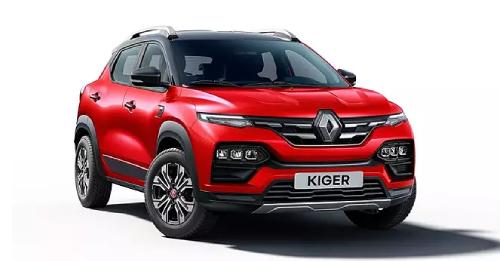Both vehicles belong to the sub-four-metre SUV segment and currently, this is the most popular segment in the country. The offerings included in this segment are the Nissan Magnite, Maruti Suzuki’s Brezza and Fronx, Hyundai Venue, Mahindra XUV300, Citroen C3, and the Tata Nexon. The Hyundai Exter will also make a foray into this segment.
Besides that, the French car manufacturer sells the Renault Kiger in petrol only, while the Korean car manufacturer sells the Kia Sonet in both petrol and diesel. For reference, there are no Renault cars in India that can be had in diesel as well.
Gradually, many carmakers are axing diesel engines- not only in India but across the globe as well. Let’s digress on that and move on to the main subject, the comparo.
The Kia Sonet and the Renault Kiger are direct rivals, which is why we are here to do a comparison between them, in terms of features and specifications. Let’s begin to weigh them.
Specifications
Before jumping to the figures, let’s talk about their chassis. The Renault Kiger is made on the Renault-Nissan-designed CMF-A+ platform that underpins the Renault Kwid and the Kwid as well as the Nissan Magnite.
On the other hand, the Kia Sonet is based on the Hyundai-Kia K2 platform, which also underpins the Hyundai Venue.
As for the Tata Punch, it is based on the ALFA-ARC platform, which is also shared with the Tata Altroz. It is also worth mentioning that these two cars boast a five-star safety rating, awarded by the Global NCAP. Speaking of ratings, the Kia Sonet has a three-star safety rating. For safety, Tata Punch is a no-brainer. In addition, the new-age Tata cars are known for achieving five-star safety ratings.
Apart from that, the Renault Kiger is available in petrol only and has two engine options: a naturally aspirated and a turbocharged. The 1.0-litre (999cc) Energy, three-cylinder, naturally-aspirated petrol engine is tuned to churn out 71.01 bhp at 6250 rpm and 96 Nm of peak torque at 3500 rpm. In parallel, the 1.0-litre (999cc), three-cylinder, turbocharged petrol engine is capable of producing 98.63 bhp at 5000 rpm and 160 Nm of peak torque at 3600 rpm.
Both engines have a standard five-speed manual transmission but have different automatic transmissions. The naturally-aspirated engine is exclusive to a five-speed AMT, while the turbocharged engine is mated to a CVT gearbox.
On the flip side, the Kia Sonet has three engine options in total: two petrol engines (naturally-aspirated and turbocharged) and one diesel engine. If you are a torque lover, check out the price of the diesel version. Here’s the Kia Sonet’s price list.

The 1.2-litre Smartstream, four-cylinder, naturally-aspirated petrol engine is tuned to churn out 81.86 bhp at 6000 rpm and 115 Nm of peak torque at 4200 rpm. The 1.0-litre Smartstream, three-cylinder, turbocharged petrol engine can churn out 118.36 bhp at 6000 rpm and 172 Nm of peak torque at 4000 rpm.
The diesel version of the Sonet is powered by a 1.5-litre CRDi WGT, four-cylinder, turbocharged engine, which is capable of producing 98.63 bhp at 4000 rpm and 240 Nm of peak torque at 2750 rpm.
That’s an impressive torque, especially for a car of its size. Check out the Sonet’s price here.
Weighing the figures, the Kia Sonet is more powerful than the Renault Kwid, irrespective of the engine type.
Keeping their engine outputs aside, let’s now jump to their suspension setups.
The Renault Kwid stands on a McPherson Strut with a lower triangle and coil spring, along with an anti-roll bar and a stabiliser bar at the front and a torsion beam axle at the rear. In contrast, the Kia Sonet has a standard suspension setup, as it stands on McPherson Strut with a coil spring at the front and coupled torsion beam axle with a coil spring at the rear.
These cars are designed keeping the conditions of Indian roads in mind. That said, they shouldn’t let you lament the ride quality they have to offer. In addition, they have also proven to absorb the bumps from potholes with ease plus they can sail through the undulations without letting the passenger(s) jostle much.
The Renault Kiger has a soft suspension than the Kia Sonet, due to which, it has more ability to absorb the rough patches.
The braking duties of these two cars are taken care of disc-drum brakes. The top-most variant of these two cars runs on alloy wheels and has steel wheels as a spare. The Kiger has a tyre profile of 195/60 R16, while the Kia Sonet has a tyre profile of 215/60 R16.
A wider tyre will offer more grip than a vehicle with a smaller tyre.
Prices and Variants
The French car manufacturer sells the Kiger in five broad variants: RXE, RXL, RXT, RXT (O) and RXZ. It has a total of fifteen variants. The Renault Kiger’s price starts at Rs 6.50 lakh for the base variant, the RXE Petrol MT, and goes up to Rs 11.23 lakh for the top variant, the RXZ Turbo CVT DT.
In contrast, the Sonet is offered in six broad variants: HTE, HTK, HTK+, HTX, HTX+ and GTX+. An Anniversary Edition is also available on the HTX trim. The new X Line trim has been introduced based on the top-spec GTX+ variant. It has a total of twenty-three variants. The Kia Sonet’s price starts at Rs 7.79 lakh and goes up to Rs 14.89 lakh. All are ex-showroom prices in Delhi, as of June 2023. Please note that these prices are subject to change without any prior notice to the customer. You can, however, visit the autoX website to access the latest location-based price list for your dream vehicle. For more, visit our website or connect with us on Facebook, Twitter, LinkedIn, Instagram, and YouTube. So, stay tuned!



